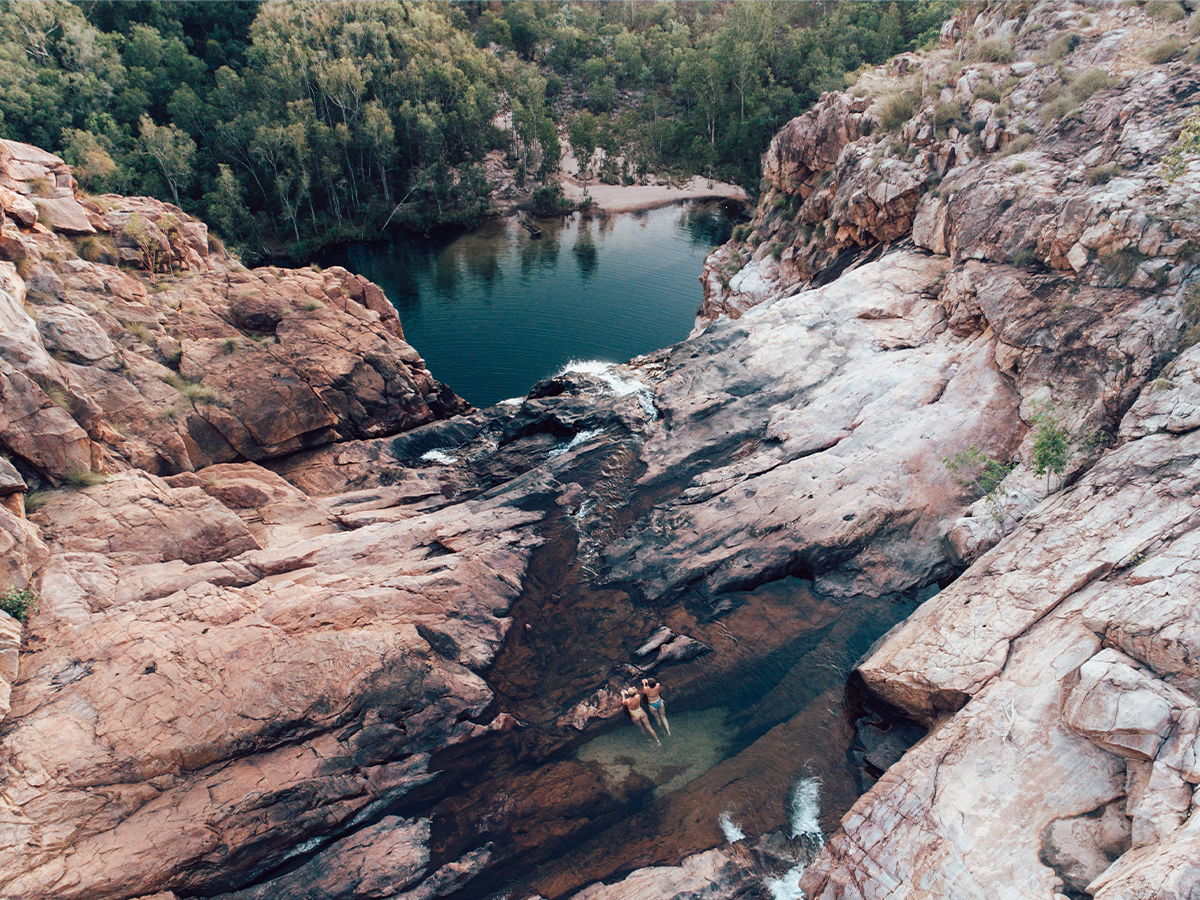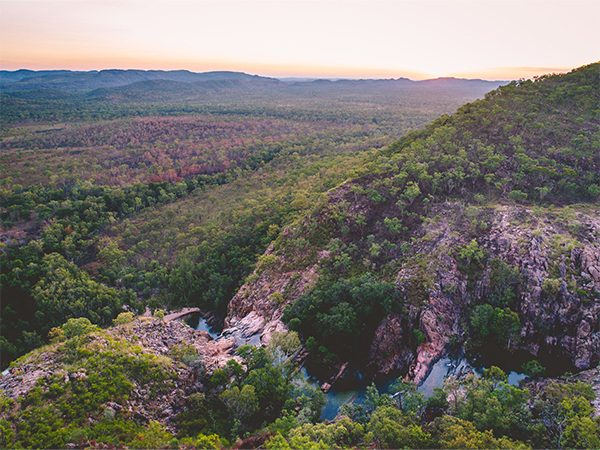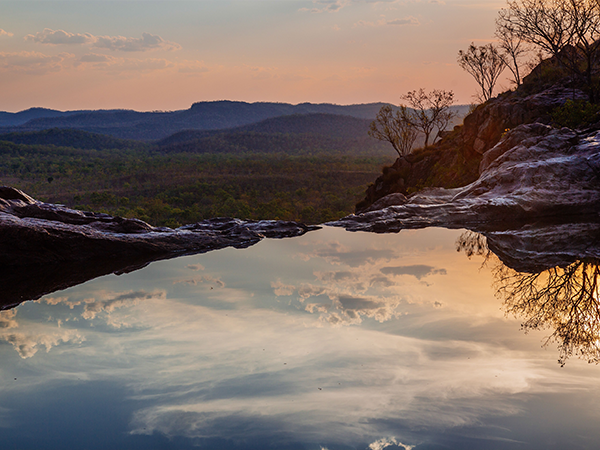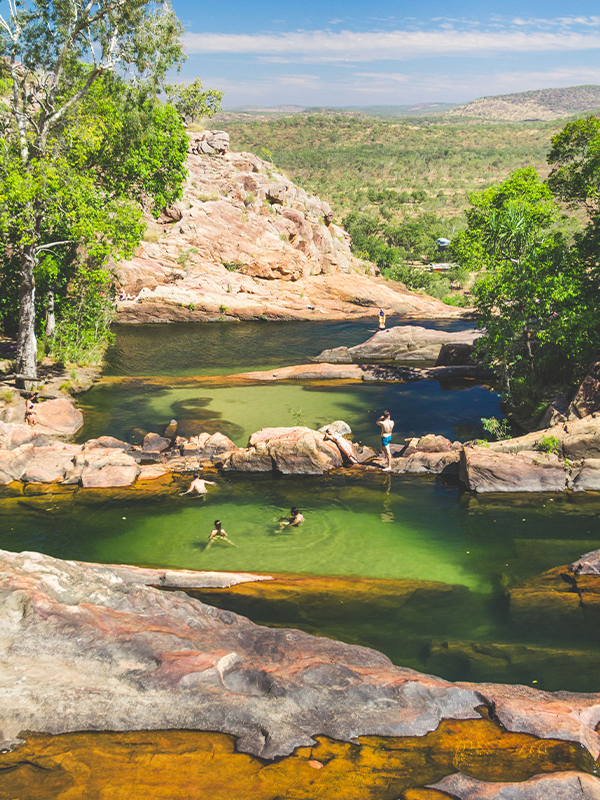02 April 2025
![]() 5 mins Read
5 mins Read

Gunlom Falls is the jewel in the crown of Kakadu National Park. This culturally significant and visually exquisite site has drawn locals and visitors for its cascading 85-metre-tall waterfall and breathtaking pools which have historically been one of the most popular swimming spots in the region. The top natural infinity pool offers spectacular views across Kakadu National Park, while the bottom pool allows you to swim in the pristine water beneath the cascading waterfall surrounded by a tranquil sandy beach.
But in 2019 the site closed and visitors haven’t been able to take a dip in the pristine pools or take photos at the site featured in the 1986 cult classic Crocodile Dundee since. This is about to change with the magnificent falls set to reopen to the public during the dry season of 2025.
Kakadu born and owner of Lord Safaris Sab Lord, has over 30 years of experience running private tours across Australia’s Top End. He collaborates with local Aboriginal guides and emphasises the importance of visiting the area for both locals and overseas visitors who want to explore its rich culture and natural beauty. “Normally, Gunlom Falls is always on my private itineraries because it’s such a beautiful location. It’s one of the most unique and exciting places to visit in Kakadu,” he said.
It’s also an important cultural site for the local Jawoyn people. Ryan Barrowei, Senior Traditional Owner and Chair of Kakadu National Park Board of Management, highlighted the importance of the area, stating:
“Gunlom is an important place for Jawoyn. This land holds stories about our culture, law, and our history. It is just as important for Jawoyn today as it was in Buwurr times (the Dreamtime). Our most powerful Ancestors, Bulajang, still reside on Jawoyn Country today. According to the Traditional Owners, Bulla – a spirit so powerful, they compare it to Armageddon – rests at Gunlom Falls, at the base of sickness country.”
According to the Traditional Owners, Bulla – a spirit so powerful, they compare it to Armageddon – rests at Gunlom Falls, at the base of sickness country.

Gunlom Falls is a place of spiritual significance and natural beauty. (Image: Lords Safaris)
In 2019, construction was undertaken for a realignment of a walking track by Parks Australia. The track was designed to improve access and safety for visitors to the iconic top pools of Gunlom Falls, but in doing so, it exposed a sacred Jawoyn men’s site to the public and damaged the area. The area was closed at the request of the Traditional Owners.
Plans for the walkway’s design deviated from what was approved by the Traditional Owners and were conducted without obtaining an authority certificate under the Northern Territory Aboriginal Sacred Sites Act 1989 (NT). The Act is integral for the protection of Aboriginal culture and heritage in the Northern Territory which prohibits a “person” from carrying out work on or using a “sacred site” without authority. The Aboriginal Areas Protection Authority (AAPA) charged the Director of National Parks (DNP) with an offence under the Act which resulted in the matter going to court.

The sunset reflected in the water of the top pool. (Image: Tourism Australia)
In September 2022, the Full Court of the Supreme Court of the Northern Territory rejected the case, ruling at the time that the DNP was immune from liability over sacred site damage. In 2023, the AAPA successfully appealed the decision in the High Court, and the current DNP pleaded guilty. The current DNP, Djungan man Ricky Archer, is the first Indigenous person to hold this position and while the damage occurred before his tenure, he apologised to the Traditional Owners. In 2024, a unanimous decision by the Full Court of the Supreme Court of the Northern Territory resulted in a $200,000 fine for the damage.
This case highlights the importance of acknowledging Aboriginal land rights and serves as a reminder to travellers to be respectful when visiting sacred sites. Matthew Ryan, NLC Chair, said in a powerful statement at last year’s hearing, “AAPA and the Traditional Owners have worked really hard over the last five years to recognise Gunlom as a sacred place. Now we can all look to the future of caring for this incredible place.”

Enjoy refreshing dips and breathtaking views. (Image: Lords Safaris)
The Traditional Owners are keen for the falls to reopen and Kakadu National Park has confirmed they will be open in time for the 2025 dry season in May. “We welcome visitors to Gunlom and ask them to come and learn about our Country and show respect while here by staying on marked tracks and following safety directions.”
When Gunlom Falls reopens, the best time to visit will be in the dry season (May to October) when there are better hiking conditions, minimal flooding, and clear, calm waters. According to Sab, the area has very few mosquitoes and is slightly cooler due to its distance from the coastal region, with temperatures being a couple of degrees lower.

Gunlom Falls is projected to reopen in the dry season. (Image: Tourism Australia)
Visitors can drive from Darwin, which takes approximately three hours via the Stuart and Arnhem highways. If you prefer not to do a self-drive or would like a more immersive experience, tours like those created by Sab will be a great way to gain insight into the area and its history and cultural significance and hear directly from First Nations people. The nearest accommodation is approximately a two-hour drive away at Cooinda Lodge, so the spacious public campground equipped with hot showers and flushing toilets is a popular choice.
LEAVE YOUR COMMENT